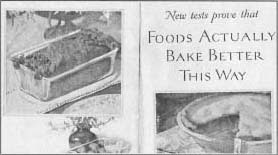>

From this. . . . . . .. . . . . . . .to this.
“It was all her idea”
The History of Pyrex
Back in the early 1900’s, Corning Glass Works was working on a request from the railroads to produce lantern glass that would not break when the hot glass was struck by rain or snow. In response to this request, Corning developed globes made from low-expansion glass that could withstand the abuses of weathering and handling which readily broke the flint glass globes. Ironically, the shatterproof lantern globes generated were so good that Corning‘s managers witnessed a decline in sales of replacement globes. This super-tough “fire glass”, as it was called, was resistant to temperature fluctuations, chemical corrosion and even breakage. Eugene Sullivan, Director of Research at Corning Glass Works, developed Nonex, a borosilicate low-expansion glass, to reduce breakage in shock-resistant lantern globes and battery jars. (Borosilicate glass was originally developed at the Jena Glass works by Otto Schott, which Sullivan had learned about as a doctoral student in Leipzig, Germany.)
In July 1913, a series of events involving Bessie Littleton, the wife of the company’s newest scientist – Dr Jessie Littleton, forced Corning managers to focus their attention on the consumer venture. Apparently, Mrs. Littleton had used a Guernsey brand casserole only twice when it fractured in the oven. Knowing the strength of the glass her husband worked with on a daily basis, she implored him to bring home a substitute from the Corning Glass Works plant. He returned the next evening with the bottoms of two sawed-off battery jars made from low-expansion glasses. Mrs. Littleton cooked a sponge cake in one of the surrogate baking dishes. She noted several remarkable findings:
• The cooking time was shorter
• The cake did not stick to the glass; it was easy to remove with little adhesion
• The cake was unusually uniform
• The flavor of the cake did not remain in the dish after washing
• She could watch the cake bake and know it was done by looking at the underside.

Mr. Littleton brought his wife’s creation to work the following day. Laboratory researchers inspected the cake, which was a “remarkable uniform shade of brown all over.” The men deemed it delicious and very well baked. (A favorite of any lab conclusion, Ed.) Thus began a two-year process to perfect this new invention. The notion of baking in glass was a whole new concept to the public. In 1915, a wondrous new line of “glass dishes for baking” appeared in the nation’s hardware, department and china stores. On May 18, 1915, Boston department store Jordan Marsh placed the first PYREX bakeware order.
The Littleton’s had a son – Harvey K Littleton. Harvey was born in 1922 and was briefly employed by the Corning Glass Works in the 1940s, where he developed his glassmaking skills and began to pursue the idea of glass as a medium for artistic expression. The earliest objects in the exhibition are two experimental cast female torsos, dating to 1942 and 1946, which are the first works in glass made by Littleton while working at Corning Glass Works. Also featured are glass vessels from the early 1960s, dating to the years just after the seminal Toledo Workshops, as well as a bottle made at the 1962 Workshops.
Click HERE to jump to the story of Harvey Littleton and his historic workshops that brought glass from the factory to the artists.
Other Glass Fun Facts to know and tell:
Glass Fun Facts: Gaffer/Composer
More Glass Fun Facts: Bullseye Glass
Float Glass Fun Facts
Glass Fun Facts – Shattered Glass Predicts Weather
Why is Glass Transparent?
Posted in "glass fun fact", "maurine littleton", 1962 workshop, art glass, bessie, harvey littleton, history, pyrex, studio glass

